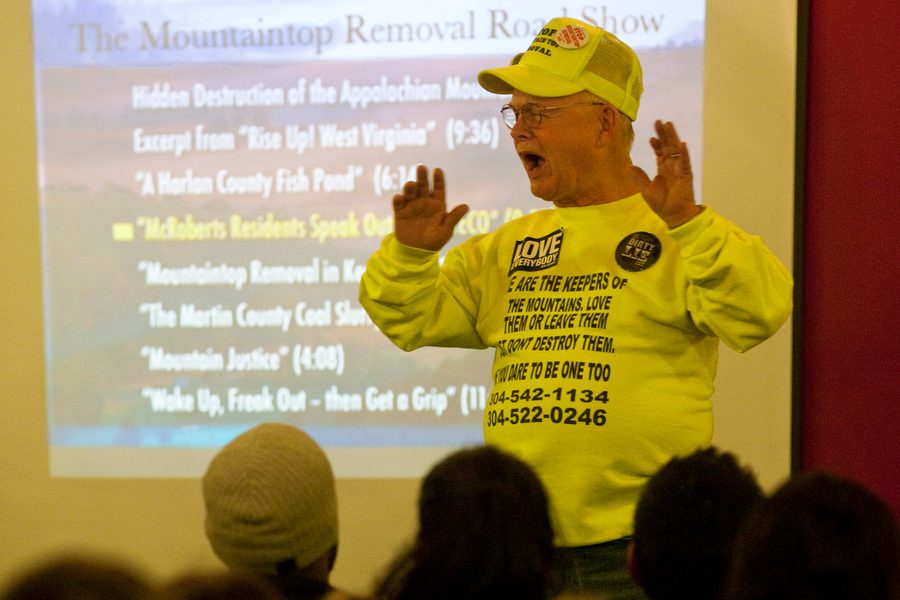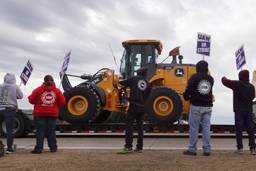The Man Who Said ‘No’ to Coal Companies: Activist Details State of Polarizing Industry
Kari Lydersen

CHICAGO — Larry Gibson’s father was a veteran of West Virginia coal mines.
“He could mine 50 pounds of coal laying on his side in a 28-inch tunnel, with a belt line,” said Gibson proudly, speaking Tuesday at Café Catedral in Chicago’s Little Village neighborhood, a few blocks from an archaic coal-burning power plant. “He worked there for 13 years before being laid off.”
Gibson himself never worked as a miner, but in the past decade it’s become a full-time job for him to fight off the coal companies who want to buy his forested mountaintop land, which they tell him is valued at $650 million, he said.
When Massey Energy originally tried to convince him to sell his land, Gibson said, they offered him $140,000. At that time, he said, a Massey vice president told him that if he held out he would become “an island” in an “ocean” of mountaintop removal strip mining.
“And he was right,” said Gibson.
The money has been hard for people to resist in a region with high unemployment and poverty. The only other work available is in Wal-Mart, fast food joints, telemarketing and mostly low-paid healthcare jobs, Gibson explained. And in the mines. But West Virginia mining jobs, once predominantly union and well-paying, have become much fewer, much lower-paying and much more likely to be non-union.
The website Political Affairs recently reported:
Data from the federal Energy Information Administration show that for 2007 (the latest year available), of 34,500 underground mining jobs, just over 10,200 were unionized; while of the 18,300 surface mining jobs, just 1,500 were unionized.
Non-union mines have notably worse safety records. An analysis by the Pittsburgh Post Gazette published in April 2010 found that of 265 coal mine deaths since 2002, only 30 were in union mines. Among recent disasters: an explosion at Massey Energy’s non-union Upper Big Branch mine in West Virginia in April 2010 that killed 29 miners.
An anecdote in the Post Gazette helps explain why non-union mines are so much more dangerous:
Deep in a coal mine in Harlan County, Ky., one day in the late 1980s, a large rock began to slip and appeared to be inches away from falling on Scott Howard and his partner. Mr. Howard refused to continue working in that area. His supervisor told him to go see the mine owner, whose response was curt.
“The next time a boss tells you to do something and you don’t do it, you won’t work for me anymore,” Mr. Howard said the owner told him. Had the mine been unionized, Mr. Howard could have reported the problem to a member of the union’s safety committee and he would have been protected from potential retaliation.
Instead, Mr. Howard filed a court action against the company, developing a reputation as a rabble-rouser that, he said, eventually cost him his job.
Gibson said coal companies like Massey are adept at public relations campaigns wherein they make it appear environmental groups and local mining opponents are destroying jobs, when in reality decent mining jobs are being shaved away by the use of high-tech machinery, temporary contract workers and general corner-cutting by companies on staffing levels and safety.
“It’s all propaganda,” Gibson said. “It wasn’t citizens or environmentalists who did away with jobs, it’s mechanization that’s killing jobs. These aren’t career jobs any more, they’re contract jobs, and the company is the only one who can break the contract.”
He said people are told that if they quit before their contract is up, they’ll actually owe the company money. “And people in Appalachia don’t have money for lawyers to challenge that kind of thing,” said Junior Walk, a young Appalachian activist.
Walk and Gibson were in Chicago to draw connections between the places coal is harvested and the places it is burned – like the the mostly low-income immigrant neighborhood where the event was being held.
Union jobs are among the arguments company officials and politicians have put forth against shutting down that coal-fired plant; though most of the workers at the plant are not from the surrounding area. The coal actually burned in Chicago comes from Wyoming, though the once-vibrant Illinois coal mining industry may see a resurgence soon as mandatory pollution control equipment on new power plants means the “dirtier” Illinois coal can be burned again.
Across the nation, only about 28 percent of miners are union, and that trend will likely be mirrored at new or reopened Illinois mines. Typically only long-standing mines have unions, and companies are known to try to dissolve unions there by renaming or closing and reopening a mine.
The Spruce Number One mine for which the permit was denied would have created 250 jobs. But mining opponents said the mountains are more valuable to the local economy intact than they are blown up to yield the coal inside them.
Ultimately, more jobs and economic well-being would be created through tourism and other enjoyment of the mountains, they say.
The battle over coal is so bitter in Appalachia that Gibson wears a bulletproof vest, keeps two guns handy and has a special door so heavy – to prevent kick-ins — that he has to slide it open on wheels. He feels he’s threatened both by actual coal company representatives and locals who work or hope to work for the coal companies. He hopes with rising awareness of the air pollution from coal-fired power and the impacts of mountaintop removal mining, his neighbors will begin to see that dangerous coal field jobs aren’t worth sacrificing their surroundings and health.
“We don’t have to use violence to make a change,” he said. “All we need is the truth.”

I hope you found this article important. Before you leave, I want to ask you to consider supporting our work with a donation. In These Times needs readers like you to help sustain our mission. We don’t depend on—or want—corporate advertising or deep-pocketed billionaires to fund our journalism. We’re supported by you, the reader, so we can focus on covering the issues that matter most to the progressive movement without fear or compromise.
Our work isn’t hidden behind a paywall because of people like you who support our journalism. We want to keep it that way. If you value the work we do and the movements we cover, please consider donating to In These Times.
Kari Lydersen is a Chicago-based journalist, author and assistant professor at Northwestern University, where she leads the investigative specialization at the Medill School of Journalism, Media, Integrated Marketing Communications. Her books include Mayor 1%: Rahm Emanuel and the Rise of Chicago’s 99%.







